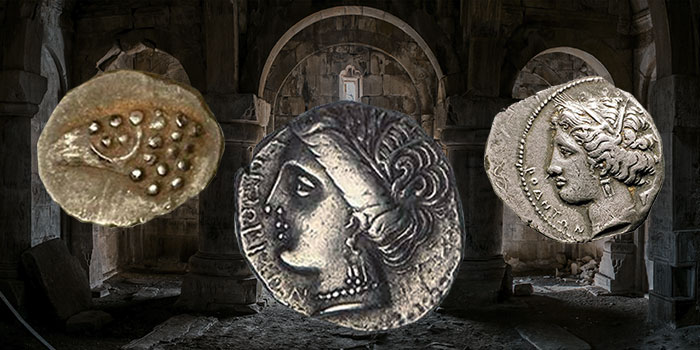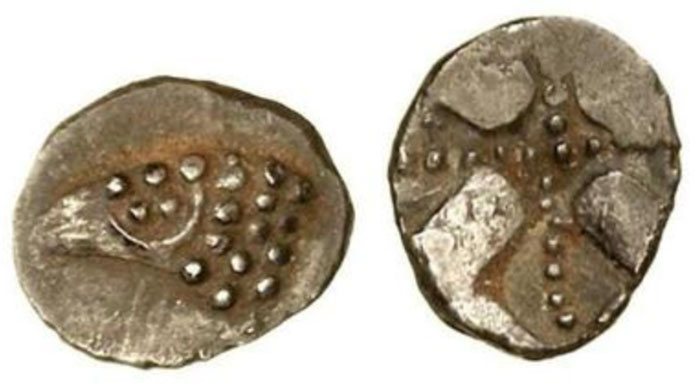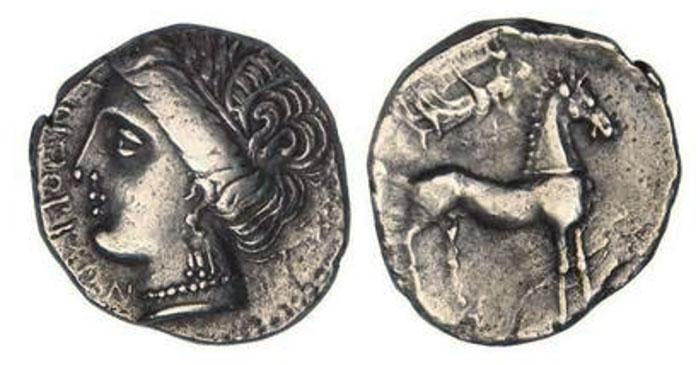
By Catawiki ……
The Iberian Peninsula is located at the western end of the Mediterranean Sea. In the late Bronze Age (early first millennium BCE) and early Iron Age (seventh century BCE), it was inhabited by various peoples who had different social, religious, and cultural structures.
Broadly speaking, the northwestern and central-eastern parts were influenced by Pre-Celtic and Celtic tribes, mainly of Central European origin. The southeastern area, which was inhabited by the Iberians from at least the sixth century BCE, was heavily influenced by Phoenicians and other Mediterranean people with whom close commercial ties had been established.
All across the peninsula there was an intensive exchange of artifacts and resources, both native and imported, as archaeological research underlines: fine Greek ceramics dating from the seventh century BCE are commonly found at Andalusian sites that were heavily influenced by Phoenicians. These ceramics were brought along by Phoenicians, and most likely given to the local chiefs with whom they traded.
According to Herodotus, the Greeks reached the Iberian Peninsula around 640 BCE—possibly after hearing of its existence from the Phoenicians. Herodotus describes the adventures of the explorer and trader Colaeus of Samos, who was welcomed by Arganthonios, king of Tartessos. In a voyage to Egypt, Colaeus’ ship was allegedly blown off course by a storm, which drove the ship past the Pillars of Herakles (the Strait of Gibraltar) into the Atlantic, where it reached the distant Tartessos, a harbor city on the south coast of Iberia rich in metal. Most likely the story of the storm is merely a myth; some suggest that it was made up by Colaeus to hide his trade route from competitors for obvious reasons: Colaeus’ ship returned to Samos loaded with silver.
The Phocaeans—originating from the Ionian city of Phokaia and the first Greeks to explore the sea—followed Colaeus’ voyage and were among the first to visit Tartessos. They established small commercial settlements where they traded wine, oil, fabrics, and bronzes for the aforementioned silver, minerals for dyes, wheat, and other natural resources, as archaeological research in cities such as Huelva shows. Not only Greek products were traded by the Phocaeans, but also many products of Phoenician origin—dating from the sixth century BCE—have been found in Huelva and several other settlements as well, which might suggest that the Phocaeans were mainly acting as intermediaries between the Phoenicians and the Tartessians.
Although sixth century BCE material from the various sites in Tartessos consists of both Greek and Phoenician products, from the mid-sixth century BCE a clear decrease of Phoenician products can be seen, and after 546 BCE, when Phokaia was conquered by the Persians, there was an overall decline in their export. The exploitation of the Tartessian market was no longer profitable for the Phocaeans so adapting to the needs of indigenous peoples, they moved their commercial activities to the eastern area of the peninsula.
To facilitate transactions between peoples, not only in Iberia but also in southern France, Italy, and North Africa, the Phocaeans introduced coinage. Initially, the natives either stored them or used them as grave goods for those considered important. A better understanding of these oval or circular shaped metal pieces came after the Phocaean colony of Massalia (modern-day Marseilles, France)—founded around 600 BCE—started coining in the late sixth-early fifth century BCE. Other nearby colonies quickly followed—or possibly began minting simultaneously—thus changing a bartering economy into a monetary economy. Stylistically but also metrologically, the early colonial coinage was heavily influenced by archaic Greek coins.
The most important Phocaean colony in the Iberian Peninsula was Emporion (modern-day San Martín de Ampurias, Girona). This colony, founded around 575 BCE and strategically situated on the trade route between Massalia and Tartessos, started issuing coins—silver fractions—at around the same time as Massalia.
Initially, numismatists assumed that Emporion was subordinate to Massalia and that it started minting in the footsteps of Massalia: silver fractions featuring a dotted ram head and an incuse (fig. 1) were regarded as the earliest Emporitan coins, and based on their style they were presumed to be made by craftsmen from Massalia. Recent studies and finds in the Emporion region contradict this: various other archaic types with an incuse that differs from the Massalian incuses show a style and weight that suggests that they were struck in Emporion before the ram/incuse issue.
Noteworthy is the Auriol Hoard, a coin hoard found in 1867 in Auriol near Marseilles comprising 2,130 silver coins. The hoard was buried after 480 BCE, and included a variety of fractional silver coins of archaic Greek style without ethnic, all from colonial mints. Although the attribution of these early types was difficult—and still the subject of discussion as both the Massalian and the Emporitan mints struck similar types—it was possible to ascribe many of them to the Emporion mint, often by looking at other findspots of similar archaic issues. These types generally followed the Phocaean weight standard—which suggests an archaic period—and feature various designs that were copied from Ionian coins: forepart of a man-headed bull/incuse; two sphinxes/incuse; head of a satyr/horse; head of Athena/head of Gorgon.
The hoard also comprised many of the previously mentioned fractions featuring the head of a ram, engraved with the dot technique, and an incuse square with a cross of dots. The large quantity of these issues suggests that they were struck several years before the hoard was concealed, possibly around 490 BCE. The aforementioned archaic types with incuses that differ from the Massalian ones predate this issue and could have been struck in Emporion in the last quarter of the sixth century BCE.
The fractional character of the issues of Emporion—and Massalia—was also appreciated outside of the colonies, as fractions are being found all across the peninsula up to Gades. Judging by the dispersion of the coins it seems likely that the increasing economic strength of both cities, but especially Emporion, was related to the popularity of the fractions. Because of the increasing wealth of Emporion, somewhere in the late fifth-early fourth century BCE Massalian colonists—possibly together with Emporitan colonists—founded a new settlement about 18 km north of Emporion: the city of Rhode (Rodeton), modern-day Santa María de Gerona.

Initially Rhode didn’t have the means to issue coins and was depending on the coinage of Emporion. Later, during the fourth century BCE, the colony introduced a silver coinage with a standard weight of 4.74 g which was based on the weight of a drachm. By doing so it changed the fractional character of the existing monetary system. The obverse of these drachms was an iconographic copy of Siculo-Punic tetradrachms, featuring a female head with corn ears in her hair—possibly Arethusa or Persephone—facing left. The reverse shows a rose seen from below, most likely a visual pun on the city’s name (the Greek ροδο / rodo translates as rose) (fig. 2). These elegant coins were appreciated by many, as they were largely copied by various Gallic peoples in the third century BCE (fig. 3).

In addition to the silver coins, as one of the first cities in Iberia, Rhode also initiated the minting of bronze coins. Often these bronze issues were overstruck on Punic Sardinian bronzes of the first half of the third century BCE.
Emporion followed Rhode and started minting drachms (of 4.70 g) instead of fractions, somewhere at the beginning of the third century BCE. The obverse of these drachms resembles the issues of Rhode—and Punic Sicily—and shows a female head facing left. The reverse, which features Nike crowning a horse, also copies Siculo-Punic tetradrachms (fig. 4). Some suggest that the Carthaginians were even involved in the process. The minting of this series ended mid-third century BCE. Bronzes with a similar reverse design were struck by the city as well in the second century BCE.

The somewhat later drachms of Emporion, struck from the mid-third century onwards, are more clearly influenced by Syracuse coins and less by Punic coinage. The female head, adorned with an ear of wheat in her hair, is now surrounded by three dolphins and the reverse design shows Pegasus (fig. 5). This typological change might be related to the decreasing Punic/Carthaginian influence after 280 BCE, or to the defeat of the Carthaginians in the First Punic War. The type can be considered as a benchmark for Iberian coinage. Later coinage of Bolskan, Cese, Titiakos, Castulo, Bastele, Iliberri, Leuni, Ursone and Untikesken (possibly located at Emporion) often featured Pegasus on the reverse. Dolphins surrounding a male head are prominently depicted on issues of Eso, Ecualacos, Clunia, Arecoratas, Cueliocos, Orkeseken, Seteiscen, Secobriga, and Otobesen.





